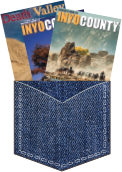Insider Tip
If you’re planning a trip, be sure to check this website for the latest on blooms. It will tell you where the best spots are and it seems to be updated every three to four days.
A word to the wise: all this bloomin’ attention has drawn plenty of crowds. There are lots of cars and motorcycles on the roads and even more people in the stores, restaurants, etc. We were stopped for over an hour when an accident shut down the road in both directions. Drive safely. And be sure to stop and smell the flowers.
Don’t Miss Death Valley in Bloom!
Spring in Death Valley is a special phenomenon. Death Valley is a land of extremes.
Many of the flowers found here in Death Valley are what we call belly flowers. These flowers are very tiny, so tiny that the best way to see or photograph them is on your belly! A magnifying glass is a great tool to have with you when you search out these wee beauties.
Being small and low to the ground is allows the flowers to stay out of the wind. You will find plants covered with fine hairs. These hairs cut down on the UV rays and keep the tender plants from being sunburned! Remember, to REALLY see Death Valley’s fabulous wildflowers, it really helps to get out of the car, walk around, and spend some time looking just a bit closer!
Death Valley National Park is known for its spectacular blooms of wildflowers. Peak wildflower blooms occur when rain falls several times during winter
-
-
- Death Valley – mid February to mid April
- Panamint Mountains (2,000 to 4,000 ft) – April to May
- Panamint Mountains (above 4,000 ft), late April to early June
- Colors include white, purple, yellow, blue, red and magenta
- Species include: desert star, blazing star, desert gold, mimulus, encelia, poppie, evening primrose, phalcelia, several cacti, Mojave desert rue, Joshua tree, bear poppies, Panamint daisies, Mojave wildrose, rabbitbrush, mariposa lilies and lupine.
-
Owens Valley Wildflower Locations Not to Miss!
-
- Division Creek, Aberdeen (fields of lupine)
- Bishop, Brockman Lane (fields of irises)
- Owens Gorge Rim (west of Bishop) (desert paintbrush, white layia, evening snow)
The long blooming season that occurs along the 150 miles of the Eastern Sierra wildflower corridor means that the window of opportunity to see some of the amazing flora of this region is over 6 months long.
At the southern end of the Owens Valley, at about 3,300 feet above sea level, large tracts of open land can present carpets of color at the start of the season. In the upper elevations of the Sierra Nevada, with peaks that rise to well over 13,000 feet, the colorful blooms in the canyons and meadows bring the season to a close.
The floral display begins at the lower elevations, beyond the Eastern Sierra in places like Mojave and Death Valley National Park, and then appears on the floor of the Owens Valley some weeks later. Thereafter the bloom grows in the foothills of the adjacent mountains and slowly creeps up the canyons and into the hanging valleys and meadows of the upper regions of these mountains.





